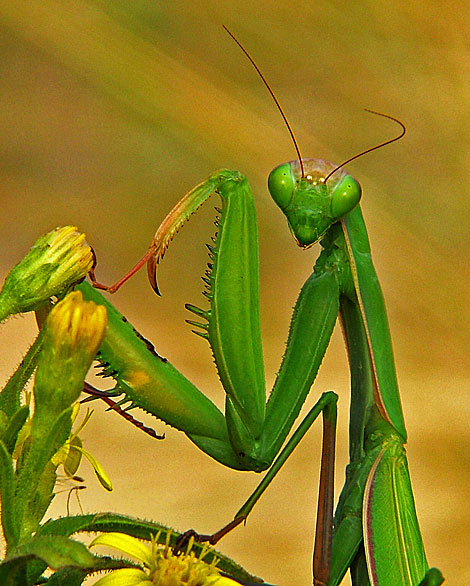 Praying mantis |
|
| If you take time to walk
through some of the lush green unspoilt countryside of Corfu
you will certainly see Dragonflies hover and shoot off only
to return and hover again. Large green grasshoppers populate
most shrubbery, and if you just pause and look close enough
a large number of of multicoloured beetles and other insects
are available for inspection. Beneath rocks Scorpions can
sometimes be found, scorpions on Corfu are not as dangerous
a one would be led to believe. Their sting is painful but
not fatal to a healthy person. Some information on other
selected species is to be found below.
|
|
| Praying mantis: - (Mantis
religiosa). The word mantis comes from the Greek word for prophet. They are related to cockroaches and grasshoppers. They feed on any insect including their own kind that they can catch with their forelegs, which are equipped with a row of hooked spines making escape almost impossible. Because of their cannibalistic nature they are solitary and are usually found motionless in undergrowth awaiting their prey. The male mantis has 8 segments on its abdomen whilst the female has 6. The female is stouter and also has a tube like ovipositor with which she lays hundreds of eggs in what is called an Ootheca. Once the young hatch they resemble ants, they moult or shed their exoskeleton numerous times during growth and after the final moult they have developed their wings. If attacked they expose their brightly coloured wings to give the impression of greater size. Colour depends on their habitat; those found in grass are usually green while those in bushes are usually browner. |
|
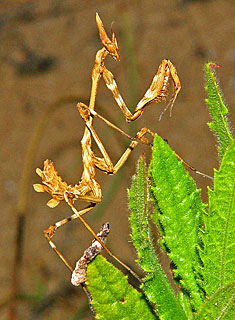 Empusa fasciata |
Mantis: - (Empusa fasciata.) This photograph is of a juvenile. The adult is more mantis like in appearance, the body becomes straighter with distinct wing cases. Adults retain the crested head and protruding flaps under the abdomen.Common throughout the Balkans.Prefers grassy shrub land.Feeds on a variety of insects. Can be found all summer long and well into October on Corfu. |
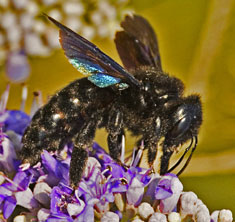 |
Carpenter Bee: - (Xylocopa violacea.) A rather large heavy looking black bee. The wings give off a violet and blue hue as seen from the photograph. Often seen bumbling through gardens and can cause alarm due to its size, although it is a placid creature and rarely harms humans. Its name is derived from its habit of burrowing in wood in order to nest. |
 Firefly |
Fireflies: - (Luciola lusitanica). Unfailingly in May each year the olive groves come alive at night with a sparkling display to rival that of the milky way, this is the annual courtship display of the Firefly. Fireflies are small carnivorous beetles, they belong to the family “Lampyridae “. The more common species is Luciola Lusitanica. They are nocturnal in behaviour, where the males fly about after dusk. The females of this species are flightless but also have wings. Both male and females emit light. The emitted light is believed to act in sexual attraction; it is produced by special light organs in the lower abdomen. |
| These special organs are a complex of air tubes and nerves, backed by a layer of specialised reflector cells. Oxygen from the air tubes converts a product called luciferin to oxyluciferin, an enzyme called luciferase assists this chemical reaction, and the end product is energy in the form of a bright green light. Fireflies are a beneficial insect in that the larvae have a voracious appetite for snails and worms which they inject with a paralysing fluid which also semi digests their prey on which the larvae then feed. | |
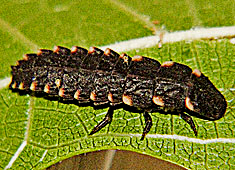 Glowworm |
Glow-worms: - (Lampyris noctiluca). Named because of the flightless, wormlike female which looks like a cross between a ladybird larvae and woodlouse, she emits a yellowish green glow to attract the male. The male resembles a duller version of the Firefly. The larvae is similar to the adult female and feed on small snails. |
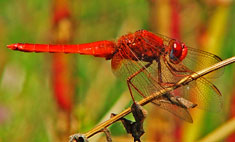 Red darter |
Red Darter: - (Crocothemis erythraea). The male of this species of dragonfly stands out like a beacon against the summer vegetation as he flitters about and lands to rest on his favourite perch. The female is browner with a yellow tint and bright yellow markings on her side. Dragonflies are unusual in that they don’t just bite and swallow their food; instead they chew food before swallowing. They can hover and fly backwards. They are distinguishable from Damselflies in that they rest with their wings open and not folded by their sides. They are beneficial to man because one of their favourite snacks are mosquito larvae during the larval stage whilst adults will take any insect on the wing including mosquitoes. Their preferred habitat is marshy terrain and waterside vegetation. The red darter is active from April to November and has a wingspan of about 65mm.
|
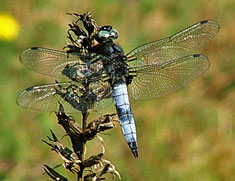 Black tailed skimmer |
Black tailed skimmer: - (Orthetrum
cancellatum). The mature male only has the blue abdomen, females and juveniles are generally light brown. Identifiable by the black tail and black patches (pterostigma) near the wing tips. Most similar species have brown pterostigma. Frequents ponds, rivers and any waterside vegetation. Wingspan is up to 80mm. Common from April to august. |
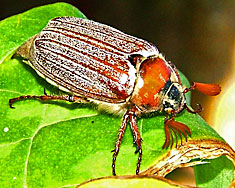 Cockchafer |
Cockchafer: - (Melolontha melolontha) The Cockchafer is a member of the Scarab family. It is also known as the May Beetle and in its larval form as the Rook worm. The adults are a common sight in the spring and early summer evenings as they habitually fly into lamps and windows only to fall to the ground beneath. They are distinguishable by their fan like antennal club, which is noticeable smaller on the female. Adults feed on leaves and flowers of trees like Oak and Lime and can cause serious damage. It is however the larvae which lives in the soil for three years that are the greater pest, their favourite food is the roots of cereal crops and grasses. The larva is a “C” shaped creamy white maggot with a brown head. |
| Despite the destruction they
cause, they do however have their uses as Jean-Henri Fabre
wrote of watching the French peasant women and children
following the plough to gather the Rookworms as a readily
available source of protein. A recipe recounted by Henri
Miot (1870) describes one of their favorite culinary dishes. "Roll the vers blancs, which are short and fat, in flour and bread crumbs, with a little salt and pepper, and wrap them in a stout piece of paper, well buttered inside. Place it in the hot embers and leave it to cook for twenty minutes, more or less, according to the degree of heat. On opening the envelope a very appetising odour exhales, which disposes one favourably to taste the delicacy, which will be more appreciated than snails, and will be declared one of the finest delicacies ever tasted." |
|
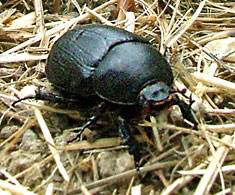 Dor beetle |
Dor Beetle: - ( Geotrupes stercorarius ) A member of a large group of beetles known as Dung beetles because of their unusual breeding habits. Animal dung is cut and rolled into a spherical shape, which can be larger than the insect itself. This is then rolled along the ground with the hind legs to a suitable location and buried; eggs are then deposited to mature in the dung. The ancient Greeks associated the Dung beetle with uncleanliness and evil, it was known as the “devils steed.” It was also associated with wealth and if one was discovered lying on its back it had to be up righted or else the persons house or crops would be destroyed by some natural disaster. |
| The Egyptian scarab beetle is
also a member of this family and in contrast was regarded as
sacred by them. They considered it a symbol of birth and
immortality, probably because of it apparently burying
itself only to be reborn as a young beetle. The scarab
beetle was also thought to roll the sun across the sky and
bury it each evening, only to dig it up the following
morning. Scarabs carved from beautiful gemstones were
regularly placed beside the heart (the only organ not
removed during mummification) of the deceased at burial, to
ensure rebirth in the afterlife.
|
|
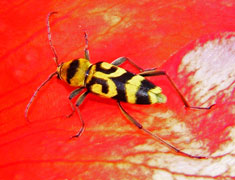 Wasp beetle |
Wasp Beetle: - (Clytus arietis) This beetle is a member of the longhorn beetle sub family. Although harmless, it mimics the appearance and movements of a wasp as protection against predators. It is about 1cm. in length and prefers open deciduous woodland with an abundance of flowers. The adult feeds mainly on pollen and the occasional small insect. The larvae feed on the wood of a number of deciduous trees that have been infested with a particular fungal growth. Quite common throughout Europe. |
 Cicada |
Cicadas: - During the hot summer months the only sound consistently heard even in the remotest olive grove is the reverberating chorus of the Cicadas. It is all pervading and even still you could easily hear a pin drop through the din - most unusual. Despite the racket they create Cicadas can be quite difficult to locate and observe. Cicadas are most unusual in that they only spend a few weeks of their entire life above ground. They are also peculiar because they cause little or no damage to crops or other foliage. This is due to their strange feeding habits. |
| The female cuts out an egg
chamber in thin branches with her saw like ovipositor, into
which she lays a number of oval cylindrical eggs. Once
hatched the nymph enclosed in a membrane with only its front
legs free, pulls itself from the nest and falls to the
ground. Immediately it burrows deep and attaches itself to a
suitable root, which it penetrates and feeds on the Xylem.
This gives them a watery, high amino acid and low sugar
diet. This continues where they dig deeper for more suitable
roots until eventually they return to the surface where they
wait until ready for their next stage of metamorphosis. The
nymph then climbs up a suitable stem to a predetermined
height or until it can climb no further, where it emerges
from its old grotesque skin to become a beautiful, singing,
flying insect (see photo sequence below). The sound comes
from special timbals on the upper side of their 1st.
abdominal segment. The ancient Greeks kept Cicadas in small
cages because they valued their singing. Metamorphosis of the cicada |
|

|

|

|

|

|

|
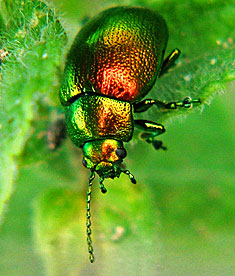 Mint leaf beetle |
Mint leaf beetle: - (Chrysolina menthastri). A small pear shaped beetle with a beautiful metallic “paint-job”. Has a strong preference for mint, but is also to be found on other plants. Likes moist shaded locations. Its length is approximately 1cm. and it is common on Corfu and throughout most of Europe from May till September. |
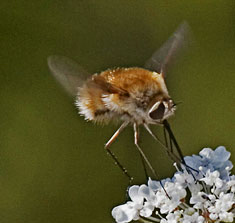 Bee fly |
Bee-fly: - (Diptera, Bombyliidae). This early flying insect is not a Bee at all, but a true fly. Its legs are much longer than a Bee’s, it only has one set of wings, its antennae are totally different to those of a Bee and in flight it is much faster. The Bee-fly also has the unusual habit of hovering and anchoring itself with its feet as it sips nectar from flowers.The Bee-fly makes its appearance very early in the year in order to lay its eggs in the unsealed nests of certain solitary wasps. Once hatched the pupae feeds on the food of the young wasps. It then goes through a transformation called hypermetamorphosis, where it changes into a more aggressive grub like larvae. At this stage of its development it proceeds to devour the young wasp larvae. When all the available food supplies of the wasps nest are exhausted, it pupates, only to emerge again next year as an adult and repeat the process all over again. |
| Download PDF version of this website with more photographs etc. in the downloads section. | |









